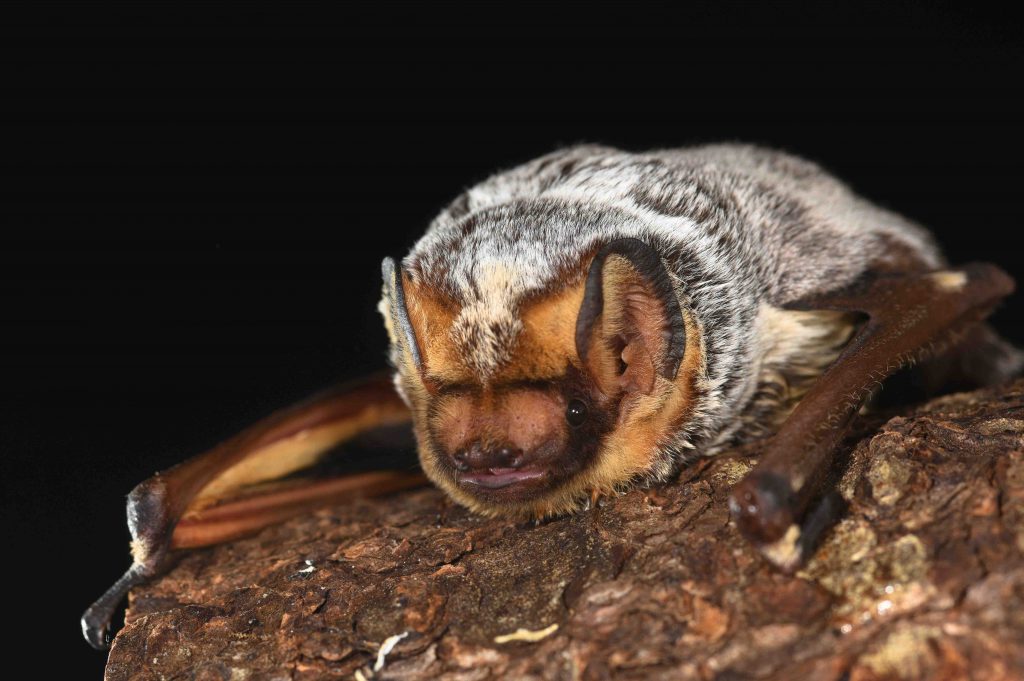
With the Ohio winter season almost over, staff and volunteers at Ohio Wildlife Center’s Wildlife Hospital are preparing more than 40 bats to “pack up” and return to their natural habitats.
The 40 Big Brown bats, two Eastern Red bats, two Silver-Haired bats and two Hoary bats currently in care – called overwintering – arrived at the Wildlife Hospital for different reasons but ended up with an extended stay to protect their survival. Whether it is interrupted migration or hibernation, the bats can’t resume their natural patterns once extreme weather arrives in the state, according to Rachel Shanks, customer service coordinator at the hospital.
“Some bat species migrate, including the Hoary bat, Eastern Red bat and Silver-Haired bats, and if they are brought to the hospital after their migration period has passed, they missed their opportunity and are stuck,” she said. “If we release them in the middle of winter to begin migrating, there are not enough insects in the environment to sustain them during the long journey,” she added.
Those such as the Big Brown bat that hibernate during winter in caves and abandoned mines end up staying at the Wildlife Hospital if they are brought in after their typical hibernation period from October to April, she added. Shanks, who obtained her Bachelor’s degree in Zoology from Ohio Wesleyan University, is now completing a capstone project in bat conservation for Oregon State University’s Wildlife Conservation and Management Graduate Certificate program.
“They cannot be released until temperatures are warm enough consistently above 50 degrees so that food sources are accessible to the bats,” she said. “Hibernation can be disturbed by irregular weather patterns, the White-Nose Syndrome disease, or if people find bats in their home,” she added. “For bats, attics can seem like the perfect “cave” for hibernation. Some are brought in by SCRAM! after homeowners find them in chimneys or attics and we take care of them during the rest of the winter.”
Providing the best care and favorite foods

While bats are overwintering, their care includes feeding them their favorite foods such as mealworms. They are kept in a temperature stable space away from loud noises because of their sensitive hearing. When spring arrives, they are returned to the neighborhoods and locations where they were originally found.
The Wildlife Hospital also enlists the help of a dedicated team of experienced home rehabilitation volunteers during the winter who focus on bat care.
Ann Wookey, a hospital, homecare and InfoLine volunteer who is also a keeper at the Columbus Zoo, has found her time with the bats to be rewarding in multiple ways.
“When I first made the decision to home care animals I chose to do bats for practical reasons,” she said. “I already had my rabies vaccine and nobody else was really doing bats, so I thought it would be a good fit for me.”
“It didn’t take long to find my passion for bats,” she added. “I found them fascinating to work with and soon realized how unique they all were.”
She made discoveries often during her time with many species in homecare.
“At first I always kept bats separated, but I realized how social they were,” she said. “I decided to try to pair some up. I had an older female and a young juvenile female. When I put them together for the first time, the older bat literally put her wing around the young one!”
“I was hooked from that moment.”
For Gwen Hoogendoorn, providing homecare for bats is a way to extend the capacity of the Wildlife Hospital when the demand is high. “Homecare is not only a critical means of support for the hospital, but it provides a low stress atmosphere and consistent care for the animal,” she noted. “The rewards that come with knowing you sustained life and the physical well-being for a creature that would not have had this opportunity otherwise are overwhelming,” she added.
Shanks, Wookey and Hoogendoorn say bats often get a bad rap because of people’s misconceptions and myths about the species.

Myths and Facts about Bats
Ohio has 13 species of bats. They are insectivorous and can eat up to 1,200 mosquito-sized insects every hour. According to Bat Conservation International, bats are invaluable for pollination, seed dispersal, pest control and fertilization across the world. Scientists estimate that in the U.S. bats are worth more than $3.7 billion a year in reduced crop damage and pesticide use. Worldwide, more than 1,100 bat species exist with fossil records of bats dating back at least 52 million years.
Contrary to what people might think, according to Shanks, bats are not blind, they do not get caught in people’s hair and they are not rodents. “They are the only mammal that can fly,” she said. They are the second largest mammal group in the world, with high vulnerability to extinction due to slow reproduction of the species. Most female bats give birth to only one pup at a time. Bat babies can weigh up to one-third of their mother’s body weight.
The Hoary bats now overwintering at the Wildlife Hospital are considered Ohio’s largest bat and they have a wingspan of almost 17 inches. They are rarely seen and spend most of their time in trees.
In addition to bats arriving at the hospital for “off season” reasons, Shanks noted the hospital is seeing more and more bats that get stuck in glue traps intended for rodents. “These sticky traps are very cruel and can really do some damage to the creatures, including bats, that get stuck on them,” she said. “
For more information about volunteering at Ohio Wildlife Center or supporting Ohio bats, go to www.ohiowildlifecenter.org.